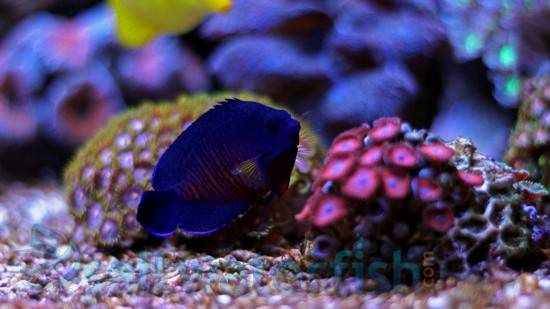Spotted Garden Eel
Heteroconger hassi
(0 Reviews)

Spotted Garden Eel
Heteroconger hassi
(0 Reviews)
{{ item.name }}
Size: {{ item.extra_field_3 }}
${{ getFormattedPrice(item.saleprice) }} ${{ getFormattedPrice(item.price) }}
To join the waiting list, click here
Free Shipping
With
$199.00
or more in Marine Life.
More details...
Spotted Garden Eel Care Facts
| Care Level: | Expert |
|---|---|
| Temperament: | Peaceful |
| Diet: | Omnivore |
| Origin: | Indo-Pacific Ocean |
| Minimum Tank Size: | 50 gallons |
| Max Size: | 14 inches |
The Spotted Garden Eel (Heteroconger hassi) can be found among sandy lagoons or stretches of seagrass throughout shallow waters. They burrow into sandy substrate where they bury the majority of their body, as well as hide among if predators approach. They have a yellow body that is peppered with small black spots. They feed on zooplankton in the water column and should have a steady current to provide new food regularly. They prefer to be in groups, should be introduced into an established tank and should have at least a 6 inch sand bed.
The Spotted Garden Eel: A Fascinating and Unique Addition to Your Saltwater Marine Aquarium
The Spotted Garden Eel (Heteroconger hassi) is a fascinating and unique addition to saltwater marine aquariums, bringing an element of intrigue and novelty to any enthusiast's collection. Originating from the Indo-Pacific region, these eels are known for their distinctive appearance and exciting behavior.
Habitat: Creating a Home for Spotted Garden Eels
Spotted Garden Eels inhabit sandy substrates in shallow coastal waters, creating caves where they spend most of their time. They prefer areas with minimal current and soft substrate for burrow construction and maintenance.
Reef Safety: Ensuring Compatibility with Spotted Garden Eel
The Spotted Garden Eel is reef-safe and poses minimal risk to coral and other invertebrates. Their burrowing behavior is focused on the substrate, reducing the likelihood of disturbance to reef structures.
Size and Lifespan: Managing the Growth and Longevity of Spotted Garden Eel
These eels typically reach 12 to 16 inches (30 to 40 cm) in captivity, making them suitable for moderately sized aquariums. They can live up to 10 years with proper care, providing enthusiasts with a long-term and rewarding experience.
Diet in Captivity: Nourishing Your Spotted Garden Eel
Spotted Garden Eels thrive on a diet of small live or frozen foods such as brine shrimp, mysis shrimp, and other meaty marine preparations. A varied diet ensures they receive nutrients for optimal health and vitality.
Aquaculture and Availability: Sustainable Choices with Spotted Garden Eel
Spotted Garden Eels are less commonly aquacultured than other marine species, but their availability to hobbyists has increased. Saltwaterfish.com is proud to offer responsibly sourced and healthy Spotted Garden Eels, ensuring a sustainable and ethical choice for enthusiasts.
Compatibility with Other Fish and Invertebrates: Fostering Harmony in Your Aquarium with Spotted Garden Eel
Spotted Garden Eels are generally peaceful and can coexist with various tank mates. However, avoiding aggressive or predatory species that may threaten these delicate eels is essential. Compatible tank mates include Gobies, Blennies, Cardinalfish, Clownfish, and small, non-aggressive wrasses.
Sexual Dimorphism: Exploring Gender Characteristics of Spotted Garden Eel
Sexual dimorphism in Spotted Garden Eels is not readily apparent, as males and females exhibit similar external characteristics. Determining gender typically requires observation of courtship and breeding behaviors.
Juvenile to Adult Coloration Changes: Witnessing the Transformative Colors of Spotted Garden Eel
As juveniles, Spotted Garden Eels display a vibrant yellowish coloration with distinct dark spots. Their coloration may shift to a more subdued or pale tone as they mature. Monitoring these changes adds an exciting dimension to observing their development in the aquarium.
Temperament: Understanding the Behavior of Spotted Garden Eel
Known for their shy and retiring nature, Spotted Garden Eels spend much of their time partially buried in the substrate, cautiously emerging to feed. Patience is vital when acclimating to a new environment, allowing them to adjust gradually and feel secure in their surroundings.
Tank Requirements: Creating the Ideal Habitat for Spotted Garden Eel
Maintaining a suitable environment for Spotted Garden Eels involves providing a tank with a minimum size of 75 gallons. The sandy substrate should be 4 inches deep to accommodate their burrowing behavior. Ensuring stable water conditions is crucial, with parameters such as pH between 8.0 and 8.4, salinity ranging from 1.022 to 1.025, water temperature at 72-78°F, and a moderate water flow to mimic their natural habitat.
Other Common Names: Aliases of Spotted Garden Eel
Spotted Garden Eels are Leopard Garden Eels or Hass's Garden Eels.
Five Compatible Tank Mates: Social Partners for Spotted Garden Eel
- Goby (e.g., Yellow Watchman Goby)
- Blenny (e.g., Midas Blenny)
- Cardinalfish (e.g., Pajama Cardinalfish)
- Clownfish (e.g., Ocellaris Clownfish)
- Wrasse (e.g., Six-Line Wrasse)
Why Choose Spotted Garden Eels from Saltwaterfish.com: Your Trusted Source for Spotted Garden Eel
Saltwaterfish.com is committed to providing high-quality marine life to hobbyists. When you choose Spotted Garden Eels from Saltwaterfish.com, you can be confident in the health and well-being of your new additions. Our eels are sourced from reputable suppliers, undergo strict quarantine procedures, and are acclimated to captive conditions, ensuring a smooth transition to your home aquarium.
In conclusion, the Spotted Garden Eel is a captivating species that adds a touch of intrigue to saltwater marine aquariums. With proper care and attention to their specific needs, enthusiasts can enjoy these eels' unique behaviors and striking appearance for years to come. Saltwaterfish.com is a reliable source for obtaining these fascinating creatures, offering marine enthusiasts a sustainable and ethical choice.
Reviewed by: Patrick Dillon on Aug. 13, 2023










